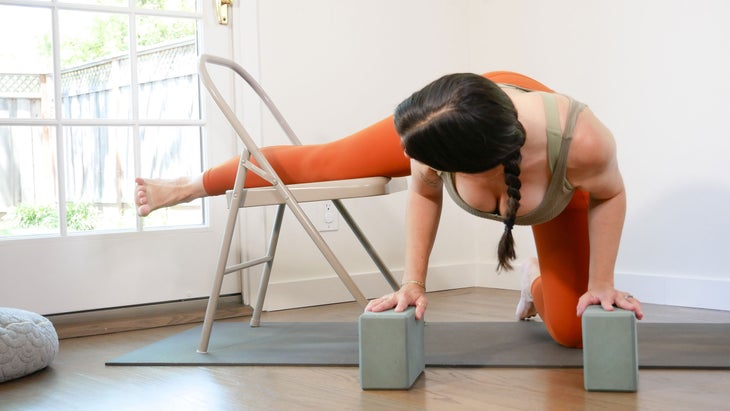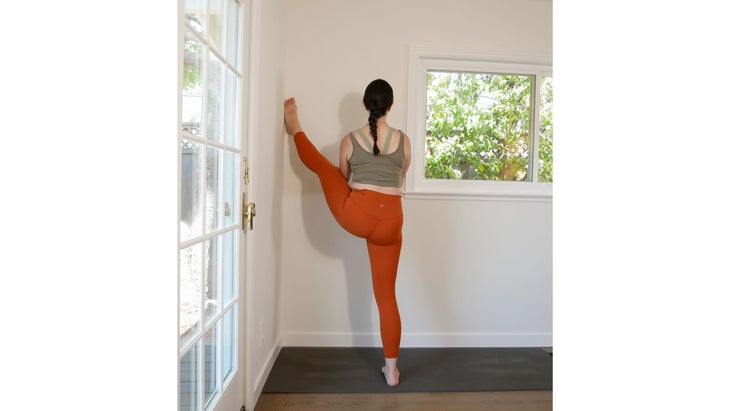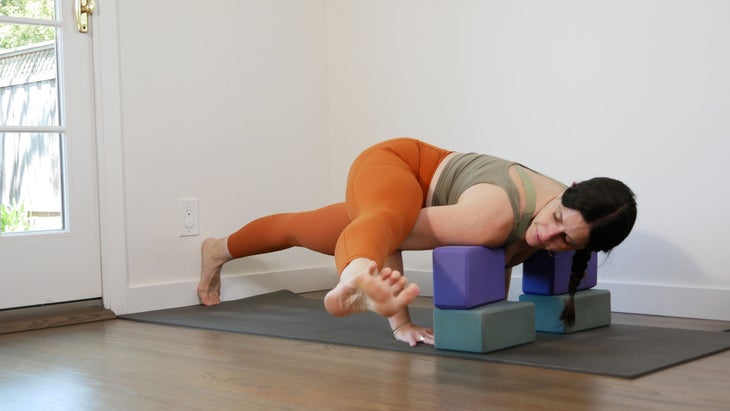A Good Prop Apply for Eka Pada Koundinyasana II
“], “filter”: { “nextExceptions”: “img, blockquote, div”, “nextContainsExceptions”: “img, blockquote, a.btn, a.o-button”} }”>
Heading out the door? Be taught this textual content on the model new Open air+ app accessible now on iOS models for members!
>”,”title”:”in-content-cta”,”kind”:”hyperlink”}}”>Receive the app.
I’ve had my share of identification crises. From as soon as I suffered my first predominant hurt and could not apply nor practice yoga, to as soon as I moved from Los Angeles to San Francisco and felt torn between the two cities, and most currently, all through the COVID-19 pandemic, as soon as I (like most teachers) needed to decide one of the simplest ways to stipulate myself on this sea of digital yoga.
Nonetheless the most important identification shift of all has been turning right into a mother. My son is now one-and-a-half years outdated, and though I am nearly once more to instructing the similar classes and doing the similar bodily actions that I was doing earlier to having him, I actually really feel completely modified, internally. It’s like starting and ending a yoga class within the similar pose—it couldn’t outwardly appear as for those who might need executed quite a bit, nevertheless inside you are feeling as for those who might need been completely rearranged.
Using postures to fulfill ourselves the place we’re
Eka Pada Koundinyasana II has been a provide of an identification catastrophe for me, too. In my early years of instructing and practising, it felt like a marker of capability. A technique to face out in packed circulation classes. I observed it as a pose I wanted to do to indicate my superior skills. The coach would say, “And must you do Flying Splits, go for it” (sometimes pretty casually, I might observe) and I would arm stability and kick my legs out in opposing directions, with no regard for the water bottles shut by or my neighbor’s head for that matter. Internally, feeling like, “See? I did it! I am a sophisticated yogi!”
As a result of the years went on and I confronted a laundry report of accidents and life modifications, I started to be way more thought of about this (and completely different) so-called “superior” poses. Over time, I found myself practising it solely as soon as I used to be appropriately warmed up and it was the peak pose versus making it some pointless add-on to knee to reverse elbow. After which I had a baby, which meant virtually two years of not doing it (spoiler alert: being pregnant is 10 months) and as soon as I attempted it for the first time, my variation was faraway from what it was as soon as:
The place I used to soar, I fell flat on my face.
The place I used to actually really feel sturdy, I felt weak and rickety.
Nonetheless there was one different enormous shift. The place I as quickly as used the pose as a measure of how superior I was—the place I as quickly as had to do it to indicate my value—I now truly benefit from working the prep poses instead. In some strategies, further so than the overall issue, because of once I’m supported with props or the wall, I can actually keep the pose and profit from the expansive nature of it.
See moreover: 4 Poses and a Meditation to Ease Postpartum Melancholy and Nervousness
Faucet into the power of pose variations
My ongoing experiences via the years of being able to bodily do one factor after which not being able to, or on the very least not virtually as merely, led me to ponder the subsequent question: If we aren’t doing the overall expression of a pose, does that suggest we aren’t doing the pose? What makes a pose a pose?
And what if we could certainly not do the “full expression” of the pose inside the first place? As soon as we apply a modified or further accessible mannequin, does this suggest we aren’t doing the pose?
A scorching topic amongst teachers who’re working laborious to create inclusive yoga areas is regarding the time interval “modification.” Some of us actually really feel that the time interval modification implies that the propped-up kind is “decrease than” or further beginner. Perhaps because of one in every of many points we unconsciously say as teachers is, “and for these of you doing the overall pose…” Instead, people are asking that we use the phrase “variation” as the thought is that the phrase implies that irrespective of mannequin any individual takes that is most acceptable for his or her physique, stays to be the pose.
See moreover: 15 Typical Poses + Variations
Exploring a novel technique to “superior yoga”
Tamika Caston-Miller, curator of Ashé Yoga and co-owner of the Ranch Houston, explains why she prefers the phrase variation: “Using completely completely different language to deal with a regression or a growth inadvertently creates ranges of yoga when yoga is previous a functionality or choice to ship one’s physique proper right into a kind. The physique modifications, our needs change, accidents occur, and as our refined yoga apply deepens, we would choose a variation of the pose that outwardly seems like a beginner posture, nevertheless inwardly shows a sophisticated practitioner’s consciousness of what he/she/they sense inside the physique.”
Irrespective of you want to identify it—a variation or modification, like Caston-Miller explains—any change you make to a posture to have the ability to work it in any other case would not suggest you are not doing the pose. That’s the superior apply: realizing what your physique needs and making intelligent choices.
Eka Pada Koundinyasana II embodies this reality. I don’t know of another posture that goes by so many different names. From Hurdler’s Pose to Albatross to Flying Splits to what we identify it proper right here at Yoga Journal, Pose Dedicated to the Sage Koundinya II. Considering that it has so many different interpretations reminds us that there’s no a way to do this posture. And that prop variations, whether or not or not the intention is to make a pose further accessible or harder, are full poses unto themselves.
3 strategies to utilize props to maneuver into Eka Pada Koundinyasana II
Do some warm-up strikes equal to Cat-Cow, just some Photo voltaic Salutations, perhaps a hip opener or two, then benefit from this pleasing Eka Pada Koundinyasana II prop apply.

Eka Pada Koundinyasana II, variation (With a chair and palms on blocks)
Benefits of this variation: There’s some debate amongst yoga teachers over what is happening with the doorway leg on this pose. Some of us think about it to be externally rotated (turned out), nevertheless everytime you prop the posture and keep it, you observe that the lifted leg is ready of abduction, which suggests the leg is being taken straight off to the side. The props on this variation help you to find this movement, with out weight-bearing, so that you presumably can keep the pose longer, which helps to elongate the groin.
Place a chair on the excessive of your mat, so that the seat goes via you. Kneel onto your shins so the chair is to your correct. Prepare two blocks in entrance of you on the low setting. Convey your leg off to the side and up onto the chair. Your leg is straight and the inseam of your complete shin and knee are on the chair seat. Work your correct shoulder beneath your leg and place your palms onto the blocks. Bend your elbows to create a shelf collectively along with your correct arm. Your left elbow is hugged in by your side and your hips are the similar stage as your shoulders. Attain your chest forward and gaze barely ahead. Take 10 breaths. Straighten your arms. Take away your leg from the chair and change your physique spherical to do side two.

In Pada Koundinyasana II, variation (Standing up on the wall)
Benefits of this variation: Whereas doing this pose, it is potential you will actually really feel like somewhat little bit of a “splat bug.” Fortunately, the wall is an amazing provide of assist. It means that you would be able to obtain the advantage of the adductor launch (your inside thighs) of the lifted leg, whereas moreover opening the hip flexors of the standing thigh—all with out having to bear weight in your arms or concern about stability. Which begs the question: If you happen to’re not balancing in your arms, is it nonetheless an arm stability? We desire to imagine so.
Uncover a nook in your space that is away from picture frames or furnishings. Stand about 6 inches from the wall and pull your left knee into your chest. Open your thigh to the left side and use your palms to straighten the leg, placing your foot inside the crease of the nook of the place the partitions meet each other. Bend your elbows and place your palms on the wall at lower ribcage and even hip peak.
Proceed to face tall, even when it means you can’t get your leg over your shoulder. Make the dimensions and spaciousness of this variation further important than hoisting the leg over your shoulder. Widen your collarbones and lengthen via your crown. Preserve for 10 breaths. Use the wall for stability and can be found out slowly. Shift to the adjoining wall, sooner than taking the second side.

Eka Pada Koundinyasana II, variation (Heels at wall, blocks beneath shoulders)
Benefits of this variation: One in all my favorite hands-on modifications on this pose is holding any individual’s once more leg. It affords them the boldness to fly. The props on this variation current that assist, which in some strategies is even cooler, because of it implies that ultimately, we’re holding ourselves up. With a bit help from the wall, in any case.
You will begin in Plank Pose collectively along with your heels on the wall, nevertheless sooner than you come into the pose, organize 4 blocks, stacked as extreme as they should be to assist your shoulders in a Chaturanga. I am a bit over 5’8” with fairly prolonged arms and the height that labored for me was the underside block on its face and the very best block on medium. Your organize will seemingly be totally completely completely different. The pleasing is in figuring out what works for you! While you solely have two blocks, try using them on medium and huge and even tall peak.
From Plank collectively along with your heels on the wall, exhale and convey your correct inside thigh in direction of your correct increased arm and begin to bend your elbows in direction of Chaturanga, making your arms proper right into a shelf for the inside leg. Prop the fronts of your shoulders in your blocks and straighten your correct leg to the side. Attain your chest forward, nevertheless on the same time, press your once more heel strongly into the wall. Preserve proper right here for 10 breaths. Bend your lifted leg and return a supported Chaturanga sooner than lowering to your knees and making able to your second side.
Watch this prop apply in movement
Want to research further? Sarah Ezrin walks us via the three methods to profit from props to look out new expressions of this difficult posture.
See moreover:
Inversion Drawback With DJ Townsel: One of the simplest ways to Nail Transitions
Use Core Power for Clear Transitions in Photo voltaic Salutations
Further yoga sequences by Sarah Ezrin
Sarah Ezrin is a yoga coach coach, mama, motivator, and creator. Based out of San Francisco, the place she lives alongside along with her husband, son, and their canine, Sarah is altering the world, instructing self-love one explicit individual at a time. Be taught further at sarahezrinyoga.com






